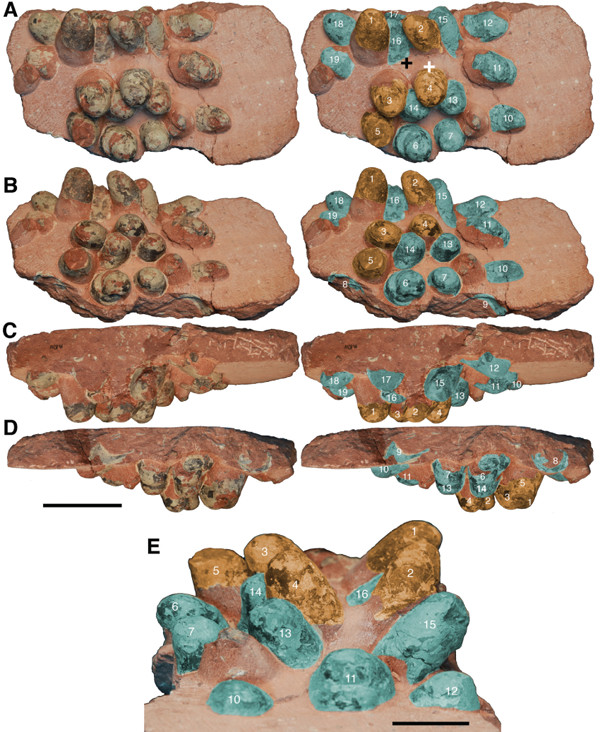
by Lucas Joel Monday, September 21, 2015

Troodon dinosaur eggs from China. Credit: David Varricchio.
Fossil dinosaur eggs and nests offer clues about dinosaur development and behavior: Based on past work, for example, scientists have thought that some dinosaurs, like oviraptors, brooded, or sat on their eggs, much like modern birds do. Now, the results of a new study describing two fossil egg nests suggest that some dinosaurs used the same nesting sites again and again.
David Varricchio, a paleontologist at Montana State University and lead author of the new study published in the Journal of Vertebrate Paleontology, and his team examined two egg nests that belonged to troodons (pronounced “troh-oh-don”), small theropod dinosaurs with long, slender hindlimbs and saw-edged teeth. Theropods include Tyrannosaurus rex as well as birds. One of the nests, preserved in mudstone in China, is about 95 million years old. The other was found in mudstone in Montana and is about 75 million years old. Each specimen preserves two different egg clutches, one atop the other.
Troodon eggs are elongate, with one end more rounded and the other more pointed. In undisturbed clutches, the rounded end touches the ground while the other end points up. The eggs from the Montana and Chinese nests preserve this orientation, indicating that they were not transported or disturbed after being laid.
In the Chinese nest, the top, unhatched clutch cross-cuts the first hatched clutch, intersecting it stratigraphically. “One could argue that there was little to no sedimentation that took place between the two,” Varricchio says. “A clutch was [laid], it hatched, and then the parent, or perhaps even a different troodon, came back to the same spot and put down another clutch.” This indicates that the troodons were likely returning to their nests repeatedly, he says.
The picture presented by the Montana nest isn’t quite as clear. There is little vertical separation between the two different clutches preserved — one overlying the other — but the small sediment-filled gap in the rock between them suggests more time passed between the two clutches compared to the Chinese nest. “It’s hard to know whether [the gap] represents a year, 10 years, 100 years, or more,” Varricchio says. Still, the clutches occur in a compact arrangement in nests with raised rims, and, because they exhibit little lateral displacement, this indicates reuse of the same nest, he says.
Today, nest reuse behavior, known as site fidelity, is seen in the two closest living relatives of dinosaurs: crocodiles and birds. Both groups reuse old nests, and also exhibit territorialism, protecting their nests against potential predators. “A lot of birds today, like loons, will return to nests if the site was successful for nesting,” Varricchio says. “If the site is consistently successful, loons will defend it to their death.”
Until now, inferring site fidelity in dinosaurs has been a challenge due to the difficulties of using the rock record from tens of millions of years ago to decipher just how closely in time different clutches were laid. “What is most surprising is that the authors found evidence of two nests in such close proximity, considering the poor preservational state of most nests,” says Darla Zelenitsky, a vertebrate paleontologist at the University of Calgary in Canada who was not involved in the new research. Although different flooding events preserved in the rock record or small amounts of sediment can represent anywhere from a season to many years of time, the new nests show as close to real-time nesting — such as a bird today returning year after year to one nest — as one could possibly expect to find in the geologic record, Zelenitsky says.
Troodons may have reused their nests, but inferring whether or not nest reuse implies that they were also territorial is harder, Varricchio says. He says he next plans to return to Egg Mountain, where the Montana clutches were discovered, to look for more complete clutches, which he hopes will offer additional insight into such questions. Other fossils preserved at the site, such as those of insects as well as animal scat, are also of interest, Varricchio says. “We’re interested in knowing more about what the whole environment was like, so that we can tease out all we can about these nesting horizons.”
© 2008-2021. All rights reserved. Any copying, redistribution or retransmission of any of the contents of this service without the expressed written permission of the American Geosciences Institute is expressly prohibited. Click here for all copyright requests.